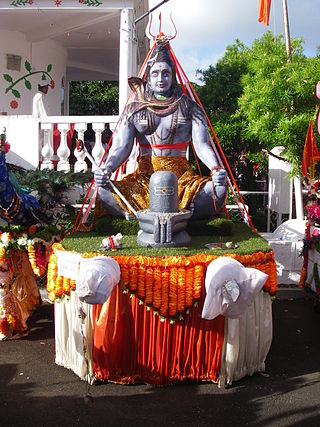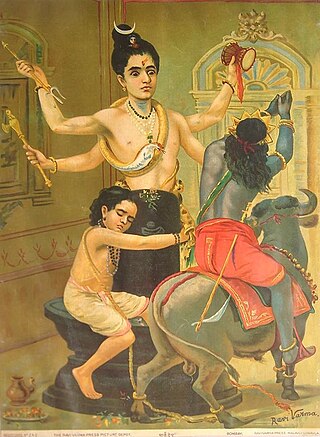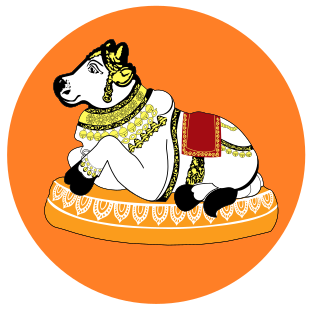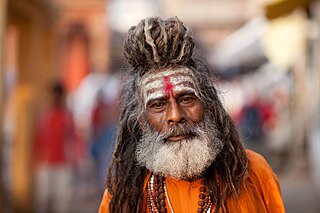Shiva Slokas
The most important prayers to invoke and please God Shiva are done on Pradosha, the thirteenth day of every fortnight in the Hindu calendar, and on Maha Shivaratri, according to Shaivism. Herein the most powerful and popular Shiva Slokas are as below:
The Mahamrityunjaya Mantra reads (IAST transliteration):
tryambakaṃ yajāmahe sugandhiṃ puṣṭi-vardhanam urvāruk miva bandhanān mṛtyor mukṣīya māmṛtāt
In the translation of Arthur Berriedale Keith (1914):
"OM. We worship and adore you, O three-eyed one, O Shiva. You are sweet gladness, the fragrance of life, who nourishes us, restores our health, and causes us to thrive. As, in due time, the stem of the cucumber weakens, and the gourd is freed from the vine, so free us from attachment and death, and do not withhold immortality."
The Panchakshara Stotra with Om:
" Om Namah Shivaya "
English translation of this mantra: "I bless the One Mind with praise and worship to Lord Shiva." "I honor the divinity within myself." "May the elements of this creation abide in me in perfection?" "May the greatest that can be in this world be created in me, in others and in this world." "I bow to Shiva."
Lingashtakam
The Lingashtakam is a popular 8-canto hymn chanted during the worship of Shiva. The lyrics are as below,
Brahma Muraari Suraarchita Lingam
Nirmala Bhashita Shobhita Lingam
Janmaja Dukha Vinaashaka Lingam
Tat Pranamaami Sadaa Shiva Lingam
Meaning: I bow before that Sada Shiva Linga, which is adored by Brahma, Vishnu and other Gods, which is praised by pure and holy speeches and which destroys the cycle of births and deaths.
Devamuni Pravaraarchita Lingam
Kaamadaham Karunaakara Lingam
Raavana Darpa Vinaashaka Lingam
Tat Pranamaami Sada Shiva Lingam
Meaning: I bow before that Sada Shiva Linga, which is the destroyer of desires, which the Devas and the sages worship, which is infinitely compassionate and which subdued the pride of Raavana.
Sarva Sugandha Sulepitha Lingam
Buddhi Vivardhana Kaarana Lingam
Siddha Suraasura Vanditha Lingam
Tat Pranamaami Sadaa Shiva Lingam
Meaning: I bow before that Sada Shiva Linga, which is lavishly smeared with variegated perfumes and scents, which elevates the power of thought and enkindles the light of discrimination, and before which the Siddhas and Suras and Asuras prostrate.
Kanaka Mahaamani Bhushitha Lingam
Phanipathi Veshtitha Shobhitha Lingam
Daksha Su yagy Vinaashaka Lingam
Tat Pranamaami Sadaa Shiva Lingam
Meaning: I bow before that Sada Shiva Linga, the destroyer of Dakshas sacrifice, which is decorated with various ornaments, studded with different gems and rubies and which glows with the garland of the serpent Lord coiled around it.
Kumkuma Chandana Lepitha Lingam
Pankaja Haara Sushobhitha Lingam
Sanchitha Paapa Vinaashaka Lingam
Tat Pranamaami Sadaa Shiva Lingam
Meaning: I bow before that Sada Shiva Linga, which is smeared with saffron and sandal paste, which is decorated with lotus garlands and which wipes out all accumulated sins.
Devaganaarchitha Sevitha Lingam
Bhaavair Bhakti Bhirevacha Lingam
Dinakara Koti Prabhakara Lingam
Tat Pranamaami Sadaa Shiva Lingam
Meaning: I bow before that Sada Shiva Linga, which is worshipped by the multitude of Gods with genuine thoughts full of faith and devotion and whose splendor is like that of a million suns.
Ashta Dalopari Veshtitha Lingam
Sarva Samudbhava Kaarana Lingam
Ashta Daridra Vinaashaka Lingam
Tat Pranamaami Sadaa Shiva Lingam
Meaning: I bow before that Sada Shiva Linga, destroyer of all poverty and misery in its eight aspects, which is the cause of all creation and which stands on the eight-petalled Lotus.
Suraguru Suravara Pujitha Lingam
Suravana Pushpa Sadaarchitha Lingam
Paraatparam Paramatmaka Lingam
Tat Pranamaami Sadaa Shiva Lingam
Meaning: I bow before that Sada Shiva Linga, which is the Transcendent Being and the Supreme Self, worshipped by all Suras and their preceptor (Brhaspathi), with innumerable flowers from the celestial gardens.



















